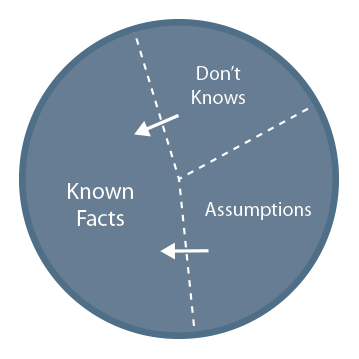Beware of your Assumptions
- Preparation takes time
- Take an early measure
- Manage your time and delegate whenever possible
- Anticipate events
- Assess your leverage
Re-Organize your data
Preparation takes time, but you can't spend all your time digging for information. You have to analyze what you know so far. But to analyze, you have to first re-organize.
You created a Need to Know list, and placed the various items of information critical to this negotiation in one of three buckets: Known Facts, Don't Knows and Assumptions. Then you researched the players, the fact base and the applicable standards and benchmarks. Now it's time to return to the Need to Know list and reorganize the items into more appropriate buckets. The goal, of course, is for your research to enable you to move those things you didn't know and those assumptions you have since tested and proven true into the Known Facts bucket.

Take an early measure
You may want to pause at this point and plot a basic scheme for the negotiation. You won't want to stay committed to it, but it gives you a way to frame the helpful data and early predictions. Following are points to help develop your basic scheme:
- Identify all interested and affected parties
- What did we learn from past negotiations and implementations of past agreements?
- Determine negotiable and non-negotiable items, and throwaways
- Identify likely sticking points and drawbacks
- What are the benefits to reaching agreement?
- Prepare response to other side's anticipated opening position
You can also use this kind of a tool when you are asked unexpectedly to provide something to the other side. For example:
You receive a phone call from the other party asking if they can delay delivery by two days. They need to know now because the crate is about to be loaded onto the rig.
Rather than respond immediately, you tell them you will call back in five minutes. You write down your thoughts about the justifications, benefits and drawbacks, and what interests you have. Writing down your thoughts forces you to think through how to address their request. Perhaps writing down the likely sticking points caused you to realize that the delay won’t hurt production, which is running behind, but in exchange you need next month’s shipment to arrive a week earlier. Now you are much better prepared to call back and respond with solutions that address both parties’ interests.
- Other work and responsibilities create distractions. Manage your time and delegate whenever possible.
Anticipate Events
Armed with information, it's time to anticipate potential objections, obstacles, and events within and out of your control. Step out of your shoes and into theirs.
Here are some helpful strategies:
- Identify Probes that address what you already know, allowing you to start slowly and build rapport, test competency, and test trustworthiness.
- Develop Probes to test your assumptions and answer your don't knows. You want to be prepared to use these Probes in the Exchange Stage to convert as many as possible of your Don't Knows and Assumptions to Known Facts as possible.
- Begin defining what the other party may know as fact versus fiction.
- Identify what they do not know that they need to know.
- Identify Probes they may ask…and be prepared with your responses.
- Assign someone on your team to play the role of the other side and plot their strategy, establish their positions, and articulate their objections.
- Prepare credible responses.
Assess Your Leverage
At this point you know a great deal of information about the stakeholders, needs and wants, and potential obstacles – yours and theirs. Now it's time to conduct a Strengths, Weakness, Opportunity, Threats (SWOT) analysis -- a review of the strengths and weaknesses from an internal perspective, and a review of the opportunities and threats from an external perspective.
Think about a negotiation you have coming up soon. You're probably used to assessing your organization's Strengths, Weaknesses, Opportunities and Threats, but do you remember to make assumptions about the other side and to adjust your strategy accordingly? Doing a SWOT analysis for your side and the other side helps you to know what additional investigation you need, what assumptions you better test, and what strategies need altering.
If You Like This Content, You’ll Love Our Training Workshops
We provide in-person and virtual training workshops to companies, government agencies, universities, and other organizations. The content of this Learning Center is a small sample of what we deliver to your teams during our live interactive classes.
To learn more, send us a note and we will be in touch soon!